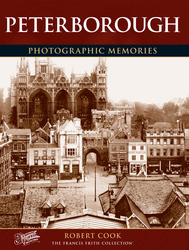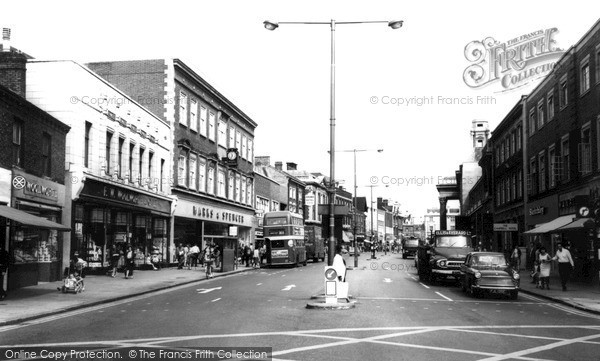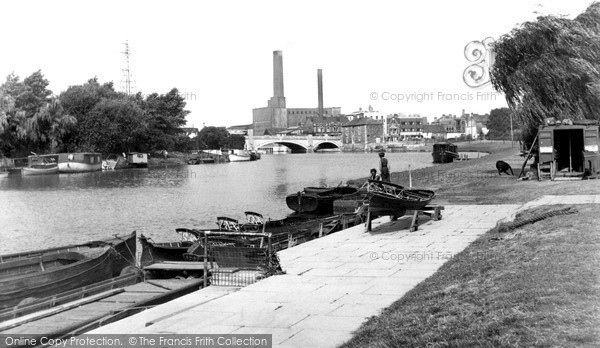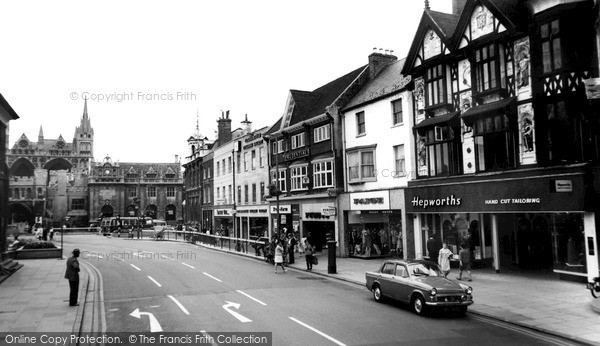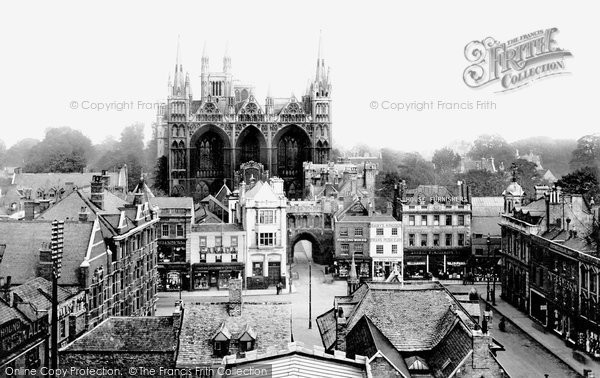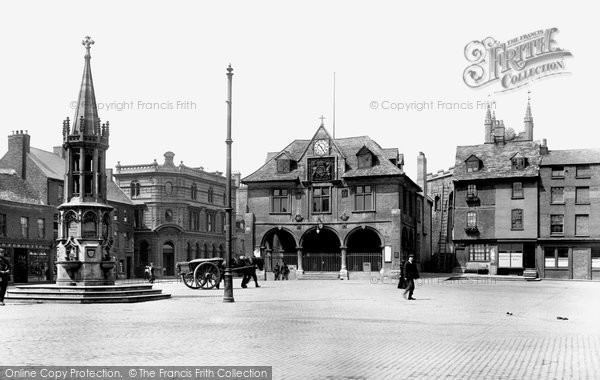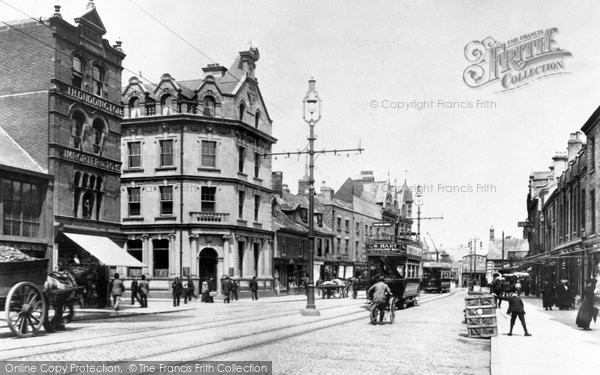Peterborough History
The history of Peterborough and specially selected photographs
The city of Peterborough is situated on a limestone promontory on the River Nene on the northern boundary of Northamptonshire where East Anglia meets the East Midlands, 75 miles north of London. It has a fascinating history, and has prospered from the produce of fields, fen and forest.
For many years the centre of the city was almost overwhelmed by the great bulk of St Peter's cathedral, a magnificent example of Norman and Early English architecture, with additions built in later years. The illustrious building has the distinction of having once had two queens, Catherine of Aragon and Mary Queen of Scots, buried beneath its paving; both were later removed to Westminster Abbey. Robert Scarlett, better known by his nickname 'old Scarlett', which suited his grim and stocky appearance, was the local man who buried them both.
Long before that period of massive upheaval in English history, the Romans built a town here called Durobrivae and a 27-acre fortress under what is now Thorpe Wood golf course; excavation even revealed evidence of prehistoric settlement here from 3,500 BC. When the Saxons arrived they called the town Medeshamstede - the name means 'settlement in the meadow'. Northamptonshire belonged to the Midland kingdom of Mercia when the pagan King Penda was killed fighting the Northumbrians in AD 654. His son and successor was a Christian, who established a monastery at Medeshamstede dedicated to St Peter; Saxulf became the first abbot in AD 675. There is nowadays debate about the extent of violence from the Danish Viking invasions. Their earliest incursions during the 9th century left evidence that East Anglia was harshly treated. The monastery was laid waste, and the Bishop of Leicester fled to Dorchester. King Alfred the Great's treaty of Wedmore in AD 878 contained the Danes, and by the 10th century Viking forces were waning. Signs of these times remain in many Danish local place-names north of the Welland. Though famed for fighting , the Vikings were a trading people; as settlers, they had helped to boost the local economy by the time that King Edward the Elder's son Aethelstan finally defeated Danelaw.
Alas, the Danes obliterated most evidence of the early monastery. St Aethelwold, Bishop of Winchester, revived the monasteries: apparently he followed a vision calling him to Oundle, where he found ruins and repaired them. Going on to Medeshamstede, he built a large new house, enclosing it with strong walls and calling it a burgh; eventually the saint's name was added to create Peter Burgh, which was later modified to Peterborough.
The Normans invaded a land governed under a system of Hundreds and Hundred Courts. Seeking improvements, they began with a little stock-taking, the Domesday survey. Abbot Leofric was close to King Harold, and died with him at Hastings. Turold, his Norman successor at Peterborough, was well-equipped as a warrior to deal with Hereward the Wake and his outlaws, who came to the city to burn it and steal treasure. The Normans needed an iron hand to defend their position nationally. Fire destroyed the Abbey again in 1116; the core of the present cathedral was built on the site as an abbey church between 1118 and 1258. The nave was built from local Barnack stone with large piers and eleven bays. The town grew as a settlement outside the abbey gates, and William added an earth and timber castle with provision for 60 knights.
During the Middle Ages, feudalism was operating with ruthless efficiency: land values rose steadily, with Northamptonshire among the most prosperous areas. The Black Death took its toll in 1349, but in the long term this promoted farming efficiency. Over-cropping and overpopulation had created crop failure, famines and epidemics. The Fens attracted much of the region's population, and the roads were busy with traders and dealers.
Religious houses tapped directly into this prosperity; Peterborough took some of the richest pickings. When Henry VIII passed the Act of Supremacy in 1534, he chose to dissolve nunneries and monasteries, pocketing a fortune. His actions originated from his need to divorce, which forced him to abandon the Catholic church. Henry knew Peterborough from his childhood; he had visited his grandmother Lady Beaufort there. He had also shown a strong interest in ecclesiastical matters since his early training for the priesthood had been cut short by his brother's death. Aiming to increase his bishoprics, Henry made the Abbey a college for priests. Removing Northampton and Rutland from the medieval see of Lincoln in 1541, he made Peterborough the centre of his new diocese.
Relative peace ensued until the English Civil War. East Anglia harboured the Parliamentarians, who were protecting the supply routes from London. Their troops showed no respect for a grand cathedral, and desecrated it with enthusiasm. The locals were pleased to see a monarch restored in 1660; they added an upper floor to their old town hall in honour of the event in 1671. An Act of Uniformity in 1662 attempted to impose religious conformity, and so boosted dissent. In 1695 Bishop White of Peterborough refused to accept William and Mary as monarchs, and lost his living. Unbridled Protestantism and its work ethic were to inspire the future.
Peterborough's population reached 3000 by 1790, though the traditional woolcombing industry was in decline. Napoleon was the national enemy, with French prisoners of war coming by boat along the Nene and being marched to a camp at Norman Cross. By 1816 the camp had outgrown the city - its population reached 10,000. The prisoners amused themselves by carving model ships from meat bones and selling them locally.
By this time the city had Improvement Commissioners, but they could not meet the people's growing needs. More money was needed. The first police force in 1874 comprised a Chief Constable, 3 sergeants and 14 men. It was plagued with drunkenness. Streets were lit by oil lamps, and toll bars were erected across city entrances. Farm and fair traffic, along with local traffic, was exempt. However, progress was slow, because politics were corrupt. The powerful Fitzwilliams were adept at buying votes. Local government reforms and secret ballots toward the end of the 19th century brought democracy a little closer. The Parliamentary Boundary Commission of 1874 included parts of Fletton and Woodston, which were integral to the local economy. Earl Fitzwilliam chaired a meeting to consider building a railway from Blisworth and Northampton to Peterborough. Parliamentary approval was gained in July 1843, and Peterborough became an important junction. Railways encouraged the local brick-making industry and the Fletton revolution.
The Fletton process was stimulated by the rapid growth of Peterborough - the population increased from 17,429 in 1871 to 30,000 in 1898. It originated in 1881 following the auction of Fletton Lodge Estate, which was sold as land with brick-making potential. The Fletton brick was born when one of the new brickmakers leasing part of the estate discarded the surface or callow clay to obtain the deeper shaley blue Oxford clay. Many more brickmakers soon discovered this material's amazing potential. Being carboniferous, it burned with only a little outside help from coal dust (called smudge). The clay lay in deep uniform good-quality strata, so excavation was relatively easy, though dangerous. The discovery sparked something like a gold rush. Crucial among the pioneers were Hempsted Bros, who leased 40 acres of the old estate at Fletton. With an established background in engineering, they had the skills to mechanise an old craft industry. Dry clay was taken to the works, where it was ground to a powder and made into bricks using presses which applied extreme pressure from four different directions. Hence, Fletton bricks under London Brick Company manufacture were trademarked as 'Phorpres'.
Presses capable of making 3000 bricks in ten hours were available by 1911. Arthur Werner Itter was a Fletton pioneer at his Saxon works near Peterborough. The bricks were fired (literally burned) in the new continuous Hoffman kilns. Heat from burning bricks in one chamber was channelled to the next, drying the bricks stacked there, thus making them easy to fire. Fire went around all the chambers, with various ones being filled, burnt or emptied. A lot of bricks had to be sold to meet the capital costs of keeping the kilns burning and digging out the huge pits or knot holes to provide the clay. J C Hill was another local pioneer; eventually, they and Hempsted Bros became part of the London Brick Company, following a series of cartels and mergers to maintain prices and reduce competition. Conventional brick-making was reduced to a rump, even though it might claim to be a better-quality hand-crafted product.
The modern London Brick Company derived its name from supplying the capital's increasing needs. The rail link was crucial, although by the 1930s the company had built up a fleet of delivery lorries which were a familiar sight in the area. By 1923, all the major Peterborough district brick yards, including Warboys and nine small independents, had been engulfed. The Second World War boosted London's brick demands for shelters and repairs, making the railways even busier.
Engineers were a vital ingredient of the modern brick industry, and the city was rich in them owing to the challenges of local agriculture. Frank Perkins was the son of a local agricultural engineer, who worked for the family firm of Barford and Perkins, helping to mechanise local farmers. Frank was surplus to requirements during the 1930s depression, and founded his own business developing high-quality diesel engines. His four circle badge became an internationally famous symbol of excellence, though early days were a struggle. A contract to provide engines for the Commer Superpoise kept his business safe. Engineering also flourished with the railways, though this industry was noted for unrest during the inter-war years.
The Second World War was perhaps Peterborough's biggest upheaval, with many newcomers to the city. Mass Observation surveys recorded that local folk were hostile to outsiders. In 1943 they reported that 'there was great resentment to American troops stationed locally'. Interestingly enough, it seems that this view was not widely shared by young local females! The survey supposed that the problem was due to the many new industries, conflict between old and new and pressure on billets and shopping. Apparently at that time 'it simply isn't fit for a decent girl to walk through the streets at night now'.
Since those good old days, much has been done to enhance the city's streets. As H F Tebbs noted in his erudite study, Peterborough was the first city to experience planned growth. Many farm workers had to leave the fens during the turn of the 19th century depression, when the Ministry of Agriculture declared that British farming was dead and fit for burial. Fortunately, railways and brick-making were there to take up the slack. During the mid 1960s, the South-East Economic Planning Council planned four major swathes of development stretching away from London: the plan aimed to make great use of motorways and existing main rail lines up to 1975, and also to accommodate growth away from London and to protect the countryside. This was the age of Milton Keynes and expanding Northampton. During these years of change, Peterborough would get caught up in the process; it experienced unprecedented growth, using all the know-how that modern planners, engineers and builders had to offer. Though the results could not please everyone, Peterborough had to move with the times, and will continue to do so.
Further Reading
To discover the histories of other local UK places, visit our Frith History homepage.
Peterborough History in Photos
More Peterborough PhotosMore Peterborough history
What you are reading here about Peterborough are excerpts from our book Peterborough Photographic Memories by Robert Cook, just one of our Photographic Memories books.
